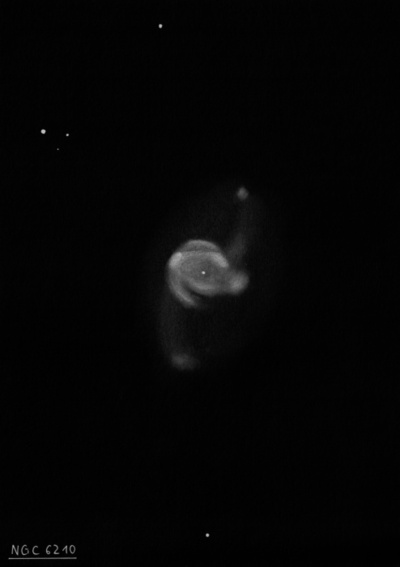
Wilhelm Struve discovered NGC 6210 = ∑ 5 = h1970 in 1825 while searching for double stars with the 9.6" Fraunhofer refractor at the Dorpat Observatory in Estonia. It was included as #5 in a list of 9 "Nebulae dectae" in an appendix to his main catalogue of double stars published in 1827. He described a "bright planetary nebula, diameter 6", like a star of mag 7". The planetary was earlier catalogued as a star in Lalande's catalogue of 1801 (LL 30510).
John Herschel observed the nebula on 25 May 1830 and recorded, "Struve's fifth nebula, very bright, equal to a star of 8 to 9m, 6" diameter and of uniform light, but with the edges boiling and ragged. A fine object like a star out of focus". Vogel observed and sketched the central star with the 27" Grubb refractor at the Vienna observatory on 4 Jun 1883. He noted a "Bright planetary nebula of elliptical shape. A delicate star is in the nebula, nearly at the centre. The nebula is surrounded by a faint elliptical shell."
On 5 May 1850, Johnstone Stoney, Lord Rosse's assistant, recorded, "intense blue centre fading off to some distance all around. Small star nf to which neb nearly extends. Fancied a projection from the bright centre towards np, but I think it was only fancy." It is possible, though, that Rosse detected the wing or extension to the northwest! James Keeler clearly sketched the wings using the Lick 36-inch refractor.
Sherburne Burnham observed the planetary in 1891 while at Lick Observatory, but did not notice the central star. Later at Yerkes (1908) he commented, "At the present time it could not be overlooked with any moderate aperture. It is nearly 12th magnitude, and appears with favorable atmospheric conditions as a sharp, brilliant point. Doubtless this has been seen by others. If it is not variable, I cannount account for my failure to see and measure it with the 36-inch at Mt. Hamilton.
Based on Crossley photographs at Lick, Curtis (1918) reported, "Central star about mag 11, surrounded by bright matter in the form of an oblong 8" in length. Outside of this is an oblong of somewhat fainter matter 20" X 13", from the ends of which extend two fainter ansae in p.a. 97-277°. From the north and south sides of the central oblong extend two longer ansae in p.a. 167-347°, showing a ring formation, making the nebula 43" long in this direction."
Wolfgang Steinicke explained why William Herschel missed NGC 6210 in his sweeps: "On 15 May 1784 he swept the region (sweep 217). However he stopped for about 30 minutes for star counts, i.e. the sky passed horizontally through the eyepiece. Unfortunately the strip runs about 1° below the nebula, starting 25 tmin west and ending 6 tmin east of it. Thus the object could not enter his field of view (15'). On 10 April 1785 he inspected the field again (sweep 395), but saw only some Flamsteed stars in the morning twilight."
300/350mm - 13.1" (7/5/83): very bright, extremely high surface brightness, blue, takes very high power. The mag 12.6 central star was not seen.
400/500mm - 17.5" (5/27/00): beautiful bluish oval at 220x, elongated 4:3 E-W, roughly 24"x18". At 380x, there appears to be a very small fainter halo. At 500x, the narrow outer envelope is more evident and is elongated in the direction of the major axis, increasing the size to ~30"x20".
17.5" (7/4/86): very bright, small blue oval 20"x15" with an unusually high surface brightness. At 572x, a fainter outer envelope is suspected. An evenly matched close double star ∑2094 = 7.4/7.7 at 1.3" lies 17' SSW.
600/800mm - 28" (7/8/13): viewed at 375x with an "inverse OIII" or central star filter, which dramatically dimmed this extremely high surface brightness green planetary. Without the filter the central star was not seen at this magnification (the planetary had a strong green color), but with the filter the central star was easily visible!
900/1200mm - 48" (5/5/16): at 488x; extremely bright, high surface brightness planetary, oval 5:4 WSW-ENE, somewhat rectangular main body. The central star was continuously visible and situated slightly east of center. A small darker region surrounds the central star. On close inspection the main body has an irregular outline, is slightly brighter along the north side and bulges out on the southwest end. A thin fainter "strip" or shell with a much lower surface brightness and a pinkish color encases the main body. Two or three broad "jets" or wings (broadest at the base) extend out of the halo on the north and south ends (images show the central part is NNW and SSE) with the northern wing more obvious. A third wing was sometimes visible on the west side.
Notes by Steve Gottlieb